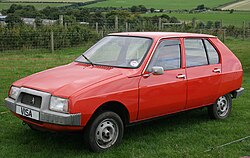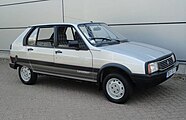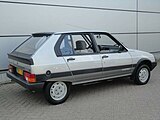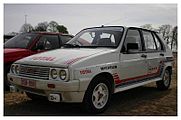Citroën Visa
| Citroën | |
|---|---|
|
Citroën Visa (1978-1981)
|
|
| Visa | |
| Production period: | 1978-1988 |
| Class : | Small car |
| Body versions : | Station wagon , convertible sedan |
| Engines: |
Otto engines : 0.7–1.6 liters (26–85 kW) Diesel engines : 1.8 liters (44 kW) |
| Length: | 3690 mm |
| Width: | 1510-1530 mm |
| Height: | 1400-1420 mm |
| Wheelbase : | 2420-2430 mm |
| Empty weight : | 725-930 kg |
| Previous model |
Citroën Ami 8 ( Citroën 2CV ) |
| successor | Citroën AX |
The Visa is a small car from the French brand Citroën , which was produced from mid-1978 to autumn 1988. The model was planned as a modern successor to the Citroën Dyane and 2CV , but production of both vehicles actually overlapped, and the 2CV even survived the Visa by two years of production.
history
In the early 1970s, Citroën developed a designated successor to the 2CV, which should have more powerful engines, a more modern chassis and a contemporary body shape based on the Citroën GS . During the development, Citroën initially worked with Fiat , because they needed a successor to the Fiat 127 . When Citroën got into financial difficulties after losing stakes in Maserati and Comotor and high expenses for modern production facilities for the Citroën CX and was taken over by Peugeot in 1974 , the new owner decided to end the cooperation with Fiat. Instead, the Peugeot 104 presented at the beginning of 1972 was chosen as the platform for the new VD (Véhicule Diminuée). A three-door version with an independent design has been deleted; instead, buyers were able to purchase a slightly modified version of the Peugeot 104 Z as the Citroën LN from autumn 1976 .
The design of the Visa body was based on a Citroën draft from before PSA affiliation, which, however, could not be implemented due to the common platform. The plans were used as part of the Oltcit SA joint venture in Romania , and the original Visa was built there under the brand name Oltcit (it eventually came back to Western Europe in the form of the Citroën Axel and had nothing in common with the Visa).
The Visa was launched in September 1978. It was fitted with the slightly enlarged, air-cooled 2-cylinder boxer engine of the Citroën 2CV with 652 cm³ (while the 2CV had a maximum of 602 cm³ engines) and modified with aluminum cylinders and electronic ignition Visa Super - equipped with water-cooled Peugeot engines.
Facelift
In March 1981, an extensive facelift was carried out under the direction of the body builder Heuliez , as the Visa was initially difficult to sell due to its unusual design (plastic radiator grille, wide C-pillars on the outside, single-spoke steering wheel and operating satellites on the inside).
Now the Visa got a more conservative front section and wide plastic planking, which should conceal the original shape of the Visa.
In April 1982 the sports version Visa GT with 59 kW (80 PS), standard 5-speed gearbox, light alloy rims with TRX wide tires, front / rear spoilers and rev counter was added to the range. The consumption of the Visa GT according to DIN 70030: 7.4 l at 120 km / h, 5.6 l at 90 km / h and 9.6 l in city traffic. The top speed was 170 km / h. The Visa GT cost around DM 14,200 in 1983, while the basic models were available from DM 9,950.
In October 1988 the production of the Visa ended.
Other body styles
Décapotable / Plein Air
The Visa was originally only available as a five-door hatchback sedan. From February 1983 a four-door convertible sedan was offered as a supplement , which was initially sold as a decapotable (French: convertible). At first there was only the equipment line Super E.
At the beginning of 1984 the name was changed to Plein Air (French: outdoors). The Super E was also replaced by the Plein Air 11 RE.
However, the production of the open visa only lasted until July 1985, as it could not establish itself as an alternative to the 2CV.
C15
In October 1984, the Visa-based panel van was introduced with the Citroën C15 .
The body resembled that of the Visa up to the B-pillar, the rear part of the car was designed independently and the wheelbase was extended. The rear swing arms of the C15 did not come from the Visa, but from the Citroën BX and were roller bearings.
The two-cylinder boxer was not offered in the C15, instead there was the small four-cylinder Peugeot 104 produced in Douvrin.
From mid-1987 petrol engines with injection (1.1i, 1.4 E and 1.4i) of the TU series and the 1.8 liter diesel (XUD series) were installed. At the end of 2000, the latter was replaced by the 1.9-liter naturally aspirated diesel from the DW series, which remained the only drive source in the range until the end of 2005.
The C15 was also available in a glazed version with five seats ( Familiale ) and in a version with an extended body and an additional side door ( Rallongé ). Since it was also offered openly without the box, there were various special bodies, including a few mobile homes, a six-wheel version and an all-wheel drive version, all of which were sold through Citroën dealers.
On December 2, 2005, production of the C15 at the Vigo plant (Spain) ended after around 1,200,000 units. In the last year of production, the C15 was only available with the 1.9 liter diesel engine in France and various other European markets such as Switzerland , Italy , Belgium and Spain .
The C15 survived the Visa - the former basic version of this series - by 17 years and, with an uninterrupted construction period of 21 years, was one of the longest-produced Citroën models ever.
Engines
Both the Visa, introduced in September 1978, and the LN, published two years earlier, were initially only available with a two-cylinder boxer engine of the 2CV, which was enlarged to 652 cm³, as a special or club . Furthermore, PSA offered both vehicles with the water-cooled 1.0-liter (10 E) and 1.1-liter engines (Super E, 11 E, 11 RE) with 33 to 37 kW from the Peugeot 104 . The air-cooled four-cylinder OHC boxer of the GS intended by Citroën for the VD project , however, was never used. Instead, a 1.4-liter four-cylinder engine with 44 kW (14 RS / TRS) appeared in July 1984.
With the introduction of the new diesel engines of the XUD series (17 D / RD) in March 1984, the Visa also received the 44 kW 1.8-liter diesel engine. The new, comparatively heavy unit, however, required major modifications to the front end and to the wheel suspension. With these changes, it was also possible to use the powerful petrol engines of the XU family in the Super X , GT and GTi versions , which even led to rally versions such as the limited 4x4 Milles Pistes .
| model | code | Type | Displacement (cm³) | power | Torque | construction time |
|---|---|---|---|---|---|---|
| Special / Club | V06 / 630, V06 / 644, V06 / 665 | Two-cylinder boxer gasoline engine | 652 | 25 kW (34 PS) at 5250 rpm | 48 Nm at 3500 rpm | 06 / 1978-10 / 1988 |
| II L / E / 10 E |
XV8 | In-line four-cylinder petrol engine | 954 | 33 kW (45 PS) at 6000 rpm | 65 Nm at 2750 rpm | 08 / 1981-10 / 1988 |
| Super / Super E / 11 E / RE |
XW7 | In-line four-cylinder petrol engine | 1124 | 35–42 kW (48–57 hp) at 5500-6250 rpm | 81.5-83 Nm at 2500-3000 rpm | 06 / 1978-10 / 1988 |
| Super X / II Super X |
XZ5X | In-line four-cylinder petrol engine | 1219 | 47 kW (64 PS) at 6000 rpm | 91 Nm at 3000 rpm | 07 / 1980-06 / 1982 |
| 14 RS / TRS | XY7 | In-line four-cylinder petrol engine | 1360 | 44 kW (60 PS) at 5000 rpm | 105 Nm at 2500 rpm | 07 / 1984-06 / 1987 |
| GT | XY8 | In-line four-cylinder petrol engine | 1360 | 59 kW (80 PS) at 5800 rpm | 108 Nm at 2800 rpm | 04 / 1982-08 / 1984 |
| GTi | XU5J 180A | In-line four-cylinder petrol engine | 1580 | 77 kW (105 PS) at 6250 rpm | 132 Nm at 4000 rpm | 09 / 1984-08 / 1986 |
| GTi | XU5JA B6D | In-line four-cylinder petrol engine | 1580 | 85 kW (115 PS) at 6500 rpm | 132 Nm at 4500 rpm | 08 / 1986-06 / 1988 |
| 4x4 Milles Pistes | In-line four-cylinder petrol engine | 1361 | 82 kW (112 hp) at 6800 rpm | 131 Nm at 4500 rpm | 09 / 1984-08 / 1986 | |
| 17 D / RD | XUD7 | In-line four-cylinder diesel | 1769 | 44 kW (60 PS) at 4600 rpm | 112 Nm at 2000 rpm | 03 / 1984-10 / 1988 |
The visa outside Europe
In the People's Republic of China , the model was offered under the Wuling brand .
Individual evidence
- ↑ Citroën Visa and C15 ( Memento from June 17, 2008 in the Internet Archive )








